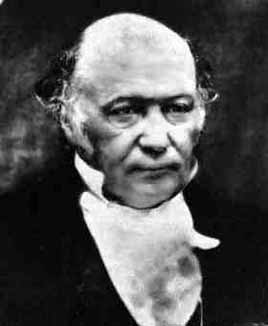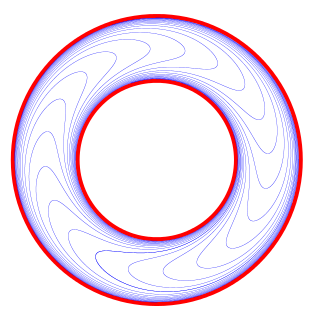In differential geometry, a subject of mathematics, a symplectic manifold is a smooth manifold, , equipped with a closed nondegenerate differential 2-form , called the symplectic form. The study of symplectic manifolds is called symplectic geometry or symplectic topology. Symplectic manifolds arise naturally in abstract formulations of classical mechanics and analytical mechanics as the cotangent bundles of manifolds. For example, in the Hamiltonian formulation of classical mechanics, which provides one of the major motivations for the field, the set of all possible configurations of a system is modeled as a manifold, and this manifold's cotangent bundle describes the phase space of the system.

In differential geometry, a Riemannian manifold is a geometric space on which many geometric notions such as distance, angles, length, volume, and curvature are defined. Euclidean space, the -sphere, hyperbolic space, and smooth surfaces in three-dimensional space, such as ellipsoids and paraboloids, are all Riemannian manifolds. Riemannian manifolds are named after German mathematician Bernhard Riemann, who first conceptualized them.

In physics, Hamiltonian mechanics is a reformulation of Lagrangian mechanics that emerged in 1833. Introduced by Sir William Rowan Hamilton, Hamiltonian mechanics replaces (generalized) velocities used in Lagrangian mechanics with (generalized) momenta. Both theories provide interpretations of classical mechanics and describe the same physical phenomena.
In mathematics, differential forms provide a unified approach to define integrands over curves, surfaces, solids, and higher-dimensional manifolds. The modern notion of differential forms was pioneered by Élie Cartan. It has many applications, especially in geometry, topology and physics.

In mathematics and classical mechanics, the Poisson bracket is an important binary operation in Hamiltonian mechanics, playing a central role in Hamilton's equations of motion, which govern the time evolution of a Hamiltonian dynamical system. The Poisson bracket also distinguishes a certain class of coordinate transformations, called canonical transformations, which map canonical coordinate systems into canonical coordinate systems. A "canonical coordinate system" consists of canonical position and momentum variables that satisfy canonical Poisson bracket relations. The set of possible canonical transformations is always very rich. For instance, it is often possible to choose the Hamiltonian itself as one of the new canonical momentum coordinates.

In mathematics, a foliation is an equivalence relation on an n-manifold, the equivalence classes being connected, injectively immersed submanifolds, all of the same dimension p, modeled on the decomposition of the real coordinate space Rn into the cosets x + Rp of the standardly embedded subspace Rp. The equivalence classes are called the leaves of the foliation. If the manifold and/or the submanifolds are required to have a piecewise-linear, differentiable, or analytic structure then one defines piecewise-linear, differentiable, or analytic foliations, respectively. In the most important case of differentiable foliation of class Cr it is usually understood that r ≥ 1. The number p is called the dimension of the foliation and q = n − p is called its codimension.

In mathematics, contact geometry is the study of a geometric structure on smooth manifolds given by a hyperplane distribution in the tangent bundle satisfying a condition called 'complete non-integrability'. Equivalently, such a distribution may be given as the kernel of a differential one-form, and the non-integrability condition translates into a maximal non-degeneracy condition on the form. These conditions are opposite to two equivalent conditions for 'complete integrability' of a hyperplane distribution, i.e. that it be tangent to a codimension one foliation on the manifold, whose equivalence is the content of the Frobenius theorem.
In physics, a first class constraint is a dynamical quantity in a constrained Hamiltonian system whose Poisson bracket with all the other constraints vanishes on the constraint surface in phase space. To calculate the first class constraint, one assumes that there are no second class constraints, or that they have been calculated previously, and their Dirac brackets generated.
In differential geometry, a field in mathematics, a Poisson manifold is a smooth manifold endowed with a Poisson structure. The notion of Poisson manifold generalises that of symplectic manifold, which in turn generalises the phase space from Hamiltonian mechanics.
In mathematics, Nambu mechanics is a generalization of Hamiltonian mechanics involving multiple Hamiltonians. Recall that Hamiltonian mechanics is based upon the flows generated by a smooth Hamiltonian over a symplectic manifold. The flows are symplectomorphisms and hence obey Liouville's theorem. This was soon generalized to flows generated by a Hamiltonian over a Poisson manifold. In 1973, Yoichiro Nambu suggested a generalization involving Nambu–Poisson manifolds with more than one Hamiltonian.
In physics and mathematics, supermanifolds are generalizations of the manifold concept based on ideas coming from supersymmetry. Several definitions are in use, some of which are described below.
In mathematical physics, geometric quantization is a mathematical approach to defining a quantum theory corresponding to a given classical theory. It attempts to carry out quantization, for which there is in general no exact recipe, in such a way that certain analogies between the classical theory and the quantum theory remain manifest. For example, the similarity between the Heisenberg equation in the Heisenberg picture of quantum mechanics and the Hamilton equation in classical physics should be built in.
In differential geometry, a field in mathematics, Darboux's theorem is a theorem providing a normal form for special classes of differential 1-forms, partially generalizing the Frobenius integration theorem. It is named after Jean Gaston Darboux who established it as the solution of the Pfaff problem.
In mathematics, the tautological one-form is a special 1-form defined on the cotangent bundle of a manifold In physics, it is used to create a correspondence between the velocity of a point in a mechanical system and its momentum, thus providing a bridge between Lagrangian mechanics and Hamiltonian mechanics.
In mathematics, integrability is a property of certain dynamical systems. While there are several distinct formal definitions, informally speaking, an integrable system is a dynamical system with sufficiently many conserved quantities, or first integrals, that its motion is confined to a submanifold of much smaller dimensionality than that of its phase space.
In differential geometry, in the category of differentiable manifolds, a fibered manifold is a surjective submersion that is, a surjective differentiable mapping such that at each point the tangent mapping is surjective, or, equivalently, its rank equals
Gennadi Sardanashvily was a theoretical physicist, a principal research scientist of Moscow State University.
In dynamical systems theory, the Liouville–Arnold theorem states that if, in a Hamiltonian dynamical system with n degrees of freedom, there are also n independent, Poisson commuting first integrals of motion, and the energy level set is compact, then there exists a canonical transformation to action-angle coordinates in which the transformed Hamiltonian is dependent only upon the action coordinates and the angle coordinates evolve linearly in time. Thus the equations of motion for the system can be solved in quadratures if the level simultaneous set conditions can be separated. The theorem is named after Joseph Liouville and Vladimir Arnold.
This is a glossary of properties and concepts in symplectic geometry in mathematics. The terms listed here cover the occurrences of symplectic geometry both in topology as well as in algebraic geometry. The glossary also includes notions from Hamiltonian geometry, Poisson geometry and geometric quantization.
Alexandr Sergeevich Mishchenko is a Russian mathematician, specializing in differential geometry and topology and their applications to mathematical modeling in the biosciences.
























